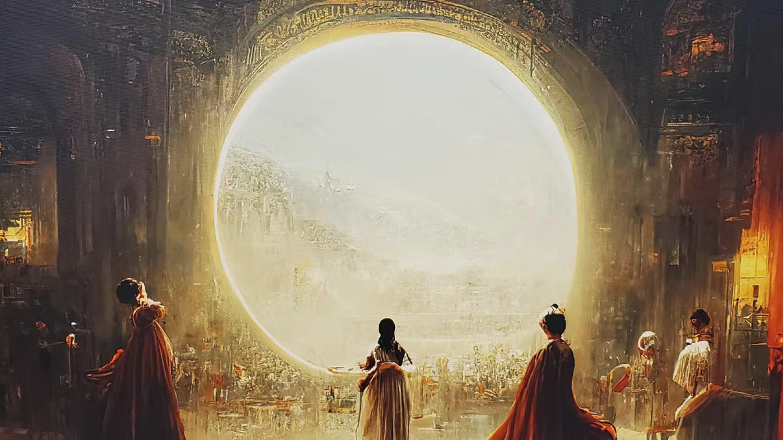AI: Artificial or Artistic Intelligence?

By Austin Wade-Vicente
“We see this technology as an engine for the imagination,” emphatically stated David Holz, creator of the popular online AI art generation program Midjourney.[1] The same program table-top games creator James Allen used this past month to win first-place in digital art at the Colorado State Fair ahead of 20 other artists.[2] Allen’s above pictured “Théâtre D’opéra Spatial” is undoubtedly an appealing work of art, but, in the era of these AI-generated masterpieces, who can legally claim ownership of this blue-ribbon piece? U.S. copyright law currently affords no copyrights for AI-generated art. As a result, this lack of ownership will only further complicate U.S. copyright law in the coming years.
Copyright law began in 1790 as a legal avenue to incentivize artists, authors, and scientists to create original works, and, in exchange, grant a monopoly over the work’s use.[3] One of the most basic requirements to claim a valid copyright is originality, which implies the product of the human hand’s creativity.[4] The landmark case Burrow Giles Lithographic Co. v. Sarony found that copyright’s originality element can be as small as choosing the costume, lighting, and pose of a person photographed.[5] AI itself will likely not be afforded human creativity status any time soon in the U.S., so it will not be able to copyright its own works.[6] However, copyrightability will become a debated topic as authorship of AI-generated works is unclear.
The copyright office and the courts have both held that non-human expression is not copyrightable. One of the most notable cases drawing this distinction was the comical Naruto v. Slater. In it, PETA sued a photographer on behalf of a monkey for the copyright of a primate selfie taken with the man’s camera.[7] Despite AI’s authorship currently resembling that of the monkey, a non-human creating art with simple tools, the relationship between human beings and AI generated art is quite different as it could be trending more towards Burrow Giles.[8]
Currently, U.S. law treats AI as nothing more than a tool developed to create and capture artistic expressions, like a camera. “When humans use a camera, they configure it (e.g., sets aperture, ISO, etc.), point and shoot.”[9] Of course the law does not consider the camera as a co-author, despite it doing the heavy lifting in capturing the image, but AI is more than just “point and shoot” in the hands of humans.[10] Take for example, the AI art generation website hotpot.ai. Users can use this free service to not only type in a unique concept and see what is generated, but it also allows users to change the image’s art style, size, medium, and even the AI model.[11] The level of control on the parameters of what can be generated echoes the level of originality first explored in Burrow-Giles to warrant copyright protection. However, the creator may be argued actually to be the copyright owner, not the user. The program creator could assert they are the party that imparts the originality of the work, while the user is more similar to the poseable subject of their AI camera.[12]
Ultimately, while copyright law has prevented this argument from taking place, it is more than likely that it will need to redefine what threshold constitutes originality in the era of AI. In order to maintain copyright law’s status quo, artists would need to be discouraged enough from years of non-copyrightable material that they are unmotivated to push these AI programs to more unprecedented artistic heights.[13] But, given AI generator DALL-E Mini’s immense user traffic this summer, it is clear that the demand for AI generated art has tremendously grown.[14] With this demand comes competition, and with competition comes more staggering improvements in AI.[15] Its art has won blue-ribbons, and its creator’s originality in its construction may also take home the gold of copyrightability sooner than we think.[16]
Image Source: https://www.nytimes.com/2022/09/02/technology/ai-artificial-intelligence-artists.html
[1] James Vincent, ‘An Engine for the Imagination:’ The Rise of AI Art Generators, The Verge (Aug. 2, 2022), https://www.theverge.com/2022/8/2/23287173/ai-image-generation-art-midjourney-multiverse-interview-david-holz.
[2] Kevin Roose, An A.I.-Generated Picture Won an Art Prize. Artists Aren’t Happy, NYT (Sept. 2, 2022), https://www.nytimes.com/2022/09/02/technology/ai-artificial-intelligence-artists.html.
[3] Copyright Timeline: A History of Copyright in the United States, Assn. of Research Lib. (last visited Sept. 2, 2022), https://www.arl.org/copyright-timeline/#:~:text=The%20law%20was%20meant%20to,providing%20creators%20with%20a%20monopoly.
[4] Jacob W. S. Schneider, AI is Improving its Artistic Skills, But Who Owns its Output?, Holland & Knight Law (Apr. 5, 2022), https://www.hklaw.com/en/insights/publications/2022/04/ai-is-improving-its-artistic-skills-but-who-owns-its-output.
[5] Burrow-Giles Lithographic Co. v. Sarony, 111 U.S. 53, 58 (1884).
[6] Blake Brittain, U.S. Appeals Court Says Artificial Intelligence Can’t be Patent Inventor, Reuters (Aug. 5, 2022), https://www.reuters.com/legal/litigation/us-appeals-court-says-artificial-intelligence-cant-be-patent-inventor-2022-08-05/.
[7] Jason Slotkin, ‘Monkey Selfie’ Lawsuit Ends With Settlement Between PETA, Photographer, NPR (Sept. 12, 2017), https://www.npr.org/sections/thetwo-way/2017/09/12/550417823/-animal-rights-advocates-photographer-compromise-over-ownership-of-monkey-selfie.
[8] See generally Vincent, supra note 1.
[9] Schneider, supra note 4.
[10] Schneider, supra note 4.
[11] See generally AI Art Maker, Hotpot (last visited Sept. 2, 2022), https://hotpot.ai/art-maker.
[12] Schneider, supra note 4.
[13] Rita Matulionyte, AI Generated Art: Who Owns the Copyright?, The Lighthouse (Jan. 16, 2020), https://lighthouse.mq.edu.au/article/december-2019/AI-generated-art-who-owns-the-copyright.
[14] Will Knight, DALL-E Mini Is the Internet’s Favorite AI Meme Machine, Wired (June 27, 2022), https://www.wired.com/story/dalle-ai-meme-machine/.
[15] See Vincent, supra note 1.
[16] Vincent, supra note 1.